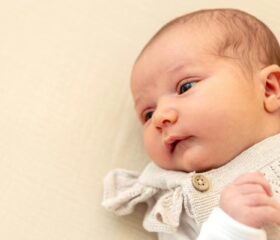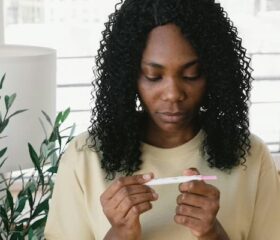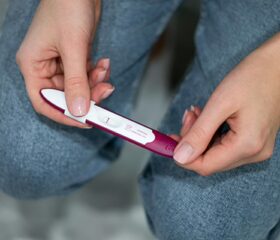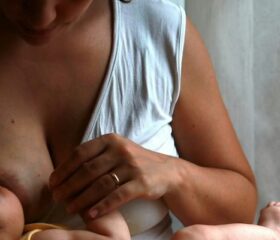Cradle Cap: Causes, Symptoms, and Effective Home Treatments
If you see crusty or scaly patches on your baby's scalp, it’s probably cradle cap.

While cradle cap might look concerning, it’s a common and generally harmless skin condition—neither painful nor itchy for your little one. 1 Those thick white or yellow scales can be persistent, but with the right approach, you can often manage them at home.
Here’s what you need to know about recognizing the signs of cradle cap and implementing the right home remedies to treat it.
What is cradle cap?
Cradle cap, also known as infantile seborrheic dermatitis, refers to those crusty patches or scales that you may see on your baby’s skin. 2 It mostly affects the scalp, hence the name, but can show up in other areas around the body, too. 1
While it can look alarming, this skin condition isn’t dangerous and shouldn’t cause any harm. 1 3
When does cradle cap appear and how long does it last?
Cradle cap usually crops up when babies are between 3 weeks old and 12 months old. Most babies—about 70%—will get it at 3 months old. 4 5
It normally lasts for a few months, but some children experience it up to when they’re 2–3 years old. 3 Your kid might have to deal with it again during puberty, as it may return as dandruff. 6
The good news is that cradle cap normally goes away on its own and will probably clear up by your baby’s first birthday. 7
What does cradle cap look like?
You’ll usually spot cradle cap on the crown and front of your baby’s scalp as greasy, flaky, yellowish or whitish patches or scales. 4 8 9
Your baby’s affected skin may be pink or red if she has a lighter skin tone, or look lighter or darker than the surrounding skin if she has darker skin. 10
While cradle cap primarily affects the scalp, similar scales can sometimes appear on the face (e.g., forehead, eyebrows, eyelids, nose creases, cheeks, and behind the ears), her upper body, and even her umbilical and diaper area. 2 4
Cradle cap is generally not itchy or painful, and it won’t interfere with your baby’s ability to sleep and eat.
Cradle cap vs. other skin conditions
It’s important to differentiate cradle cap from other skin conditions that look similar, such as: 4
- Eczema (atopic dermatitis): Unlike cradle cap, eczema causes moderate to intense itching that may disrupt your baby’s sleep and feeding. It shows up as red, scaly, and sometimes crusty patches with undefined edges on the cheeks, scalp, and the outer sides of the arms and legs.
- Diaper rash (diaper dermatitis): Seborrheic dermatitis can sometimes occur in the diaper area, but it’s different from typical diaper rash caused by irritation from urine or stool, which leads to redness, bumps, scales, and raw-looking skin in the diaper area. It normally spares the innermost skin folds. 11
- Bullous impetigo: This skin condition starts as small blisters that turn into larger, easily broken ones filled with clear or yellowish fluid that may become cloudy or darker over time. These blisters grow in skin folds, on the body, and sometimes even inside the mouth. 12
- Tinea capitis: This fungal infection is probably more commonly known as ringworm or herpes tonsurans infection. Like cradle cap, it can affect your baby’s scalp, but often also involves swollen lymph nodes and hair loss. 13 It’s confirmed with a fungal test.
If you’re not sure what type of skin condition your baby’s dealing with, it’s a good idea to call your pediatrician and schedule an appointment. Consider documenting any changes in your baby’s skin condition in a baby tracker app. Some of the best baby trackers provide a journal feature to record things with pictures and notes.
What causes cradle cap?
Doctors don’t know exactly what causes cradle cap, but there are two main theories: 4
- Hormones: Hormones passed from you to your baby before birth can stimulate her oil glands, leading to an overproduction of sebum (oil). The idea is that having too much sebum can cause dead skin cells to stick to her scalp instead of falling off normally, leading to cradle cap.
- Yeast: Another possible cause is a type of yeast called Malassezia, which breaks down the sebum on the skin and leaves behind irritating substances that may contribute to cradle cap. Specific types of Malassezia are found in most cases of seborrheic dermatitis. Note that this yeast is also present on the skin of many healthy people, so some babies might just be more sensitive to it.
Even though yeast may play a part, cradle cap isn’t a type of infection. It’s not contagious, nor is it a mark of poor hygiene or an allergy. 2
Interestingly, your baby is more at risk of cradle cap if she has a family member with eczema or asthma. 4 If your baby has severe cradle cap, that can also be an early sign of eczema (especially if there’s a family history). 14
There’s nothing you can do to prevent cradle cap
Unfortunately, there’s no way to prevent cradle cap since the cause of it is unknown. 4 Regular (gentle) scalp care can minimize its occurrence and severity. Note that cradle cap can return even after treatment, especially in your baby’s first year. 15 Try not to get too frustrated if that happens—repeat your home care remedies and see your pediatrician if it doesn’t work.
How to care for your baby’s cradle cap at home
In most cases, cradle cap resolves on its own within a few weeks or months. However, there are several home care measures you can take to help loosen the scales and improve your baby’s scalp condition.
Here’s a simple regimen you can try: 4 16 17
- Emollients: You can apply a small amount of emollient (moisturizer), such as petroleum jelly, mineral oil, or baby oil, to your baby’s scalp. Don’t use olive oil, as it may damage your baby’s skin barrier. Carefully work the emollient into your baby’s scalp and leave it on for a few minutes (or even overnight) to soften the scales. Be sure to thoroughly wash it out after.
- Gentle shampoos: Wash your baby’s hair frequently (as often as every other day or however often your pediatrician thinks is okay). Stick to a mild, fragrance-free baby shampoo and gently massage the scalp with your fingertips or a soft washcloth to loosen the scales. Rinse thoroughly to remove all shampoo residue.
- Soft brushes: After shampooing, use a very soft brush to gently brush your baby’s scalp in order to remove flakes. You can use a baby hairbrush, a new, soft toothbrush, or even a special cradle cap comb and brush.
Don’t pick or scratch at the scales, no matter how tempting it is. This can irritate your baby’s scalp and lead to infection. 16
On the topic of emollients, some natural oils are comedogenic, meaning they clog pores and can worsen skin conditions. 18 Others (like peanut oil) may cause allergic reactions in sensitive babies. 10 Always check with your doctor before using any product on your baby, and test a small area of skin first (discontinue use if you see any irritation).
Can breast milk help get rid of cradle cap?
You’ve probably heard that a dab of breastmilk can fix skin conditions like eczema, diaper rash, and baby acne due to its antibacterial properties.
However, there’s not a lot of concrete scientific evidence that breast milk is an effective treatment for skin issues. 19 20 21
Leaving breast milk on your baby’s skin probably won’t cause any issues, but it also probably won’t alleviate cradle cap any better than regular emollients.
When to seek medical advice for your baby’s cradle cap
Most cases of cradle cap resolve on their own, so consult your pediatrician if your baby’s condition gets worse or lasts longer than 2 weeks with home treatment. 22
You should also call your pediatrician if your baby: 17 23
- Develops a rash that spreads beyond her hair to her face or body
- Is less than a month old and develops blisters or pimples
- Is losing hair
- Has a smell coming from the rash
- Seems to be in pain or very itchy or uncomfortable
While it’s rare, your baby may develop a scalp infection. 3 Go see your pediatrician immediately if your baby’s skin becomes inflamed, swollen, or hot to touch, or if it bleeds or oozes pus. With an infection, she may also develop a fever of 100.4 °F and appear generally unwell. 7 24
How your doctor will treat cradle cap
If home treatment fails, your doctor may recommend prescription-strength treatments such as: 4
- Topical treatments: Your doctor may prescribe an antifungal cream such as ketoconazole 2% (especially for skin folds and creases) or a topical steroid cream such as hydrocortisone 1% for 1–2 weeks.
- Medicated shampoos: Shampoos containing ketoconazole can control yeast overgrowth and reduce inflammation. 1 25
If your baby develops an infection (which, again, is rare), your doctor will treat her with antibiotics to help her recover.
Final thoughts
Seeing scales and crusts on your baby’s head can be unsettling, but remember that cradle cap is a common and harmless condition. It’s not a reflection of your parenting skills or hygiene practices. In most cases, cradle cap will resolve on its own or with simple home care measures.
If you have any concerns or questions, don’t hesitate to reach out to your pediatrician for guidance and support. You can help your baby’s scalp stay healthy with patience and gentle care.
Article Sources
- Harvard Health Publishing. "Seborrheic dermatitis" Retrieved July 22, 2025.
- University of Rochester Medical Center. "Cradle Cap" Retrieved July 22, 2025.
- MedlinePlus. "Cradle Cap" Retrieved July 22, 2025.
- StatPearls. "Cradle Cap" Retrieved July 22, 2025.
- HealthyChildren.org. "What is Cradle Cap?" Retrieved July 22, 2025.
- Nemours KidsHealth. "Cradle Cap (Seborrheic Dermatitis) in Infants" Retrieved July 22, 2025.
- Ignite Healthwise. "Newborn Rashes and Skin Conditions" Retrieved July 22, 2025.
- The Well. "Cradle Cap Remedies That Really Work" Retrieved July 22, 2025.
- Children's Hospital of Philadelphia. "Seborrheic Dermatitis (Cradle Cap)" Retrieved July 22, 2025.
- National Health Service. "Cradle Cap" Retrieved July 22, 2025.
- StatPearls. "Diaper Dermatitis" Retrieved July 22, 2025.
- StatPearls. "Impetigo" Retrieved July 22, 2025.
- StatPearls. "Tinea Capitis" Retrieved July 22, 2025.
- National Eczema Society. "Seborrhoeic dermatitis and cradle cap in infants factsheet" Retrieved July 22, 2025.
- Johns Hopkins Medicine. "Seborrheic Dermatitis (Cradle Cap)" Retrieved July 22, 2025.
- National Eczema Association. "Seborrheic Dermatitis" Retrieved July 22, 2025.
- American Academy of Dermatology Association. "How to treat cradle cap" Retrieved July 22, 2025.
- Healthline. "Noncomedogenic Oils" Retrieved July 22, 2025.
- MedicalNewsToday. "Breast milk for eczema: What to know" Retrieved July 22, 2025.
- Dermatology Reports. "Assessment Effect of Breast Milk on Diaper Dermatitis" Retrieved July 22, 2025.
- Healthline. "How to Use Breast Milk to Treat Baby Acne" Retrieved July 22, 2025.
- St. Louis Children's Hospital. "Cradle Cap: What You Should Know" Retrieved July 22, 2025.
- Seattle Children’s. "Cradle Cap" Retrieved July 22, 2025.
- Mount Sinai. "Cradle Cap" Retrieved July 22, 2025.
- Healthline. "A Guide to Ketoconazole Shampoo" Retrieved July 22, 2025.







